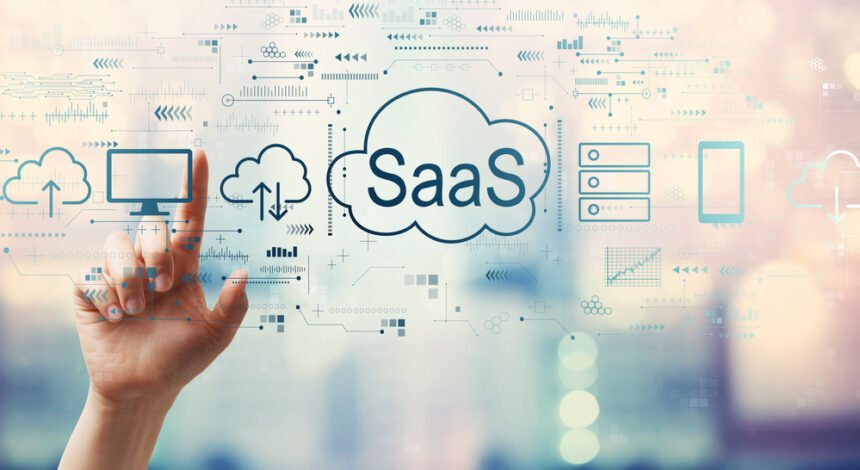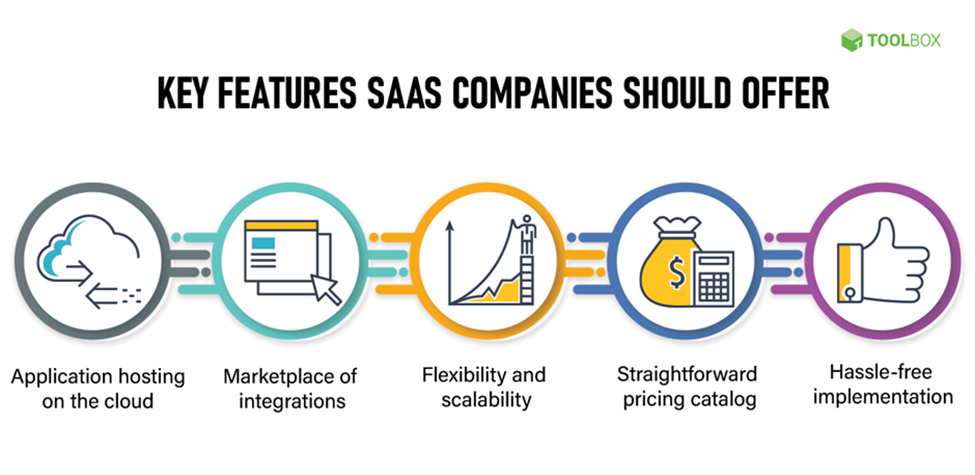In today’s more competitive, technology-driven corporate environment, all firms seeking to increase activity and productivity are reaping the benefits of the software world. The software industry is quite diverse, with solutions that may fulfill practically any potential business requirement, whether it be increased cloud computing capabilities, artificial intelligence-based automation tools, or merchant processing choices.
The abbreviation for software as a service is “SaaS.” Software as a service (SaaS) is a software licensing and delivery paradigm in which software is licensed on a subscription basis and is hosted centrally.
The SaaS business model is gaining acceptance throughout the world. Companies of all sizes are already embracing SaaS as the superior alternative to on-premise hardware and software development. A Computer Economics survey reports that 60% of organizations have now integrated some SaaS solutions into their operations, with approximately 36% planning to expand their investment in the coming months.
Choosing the appropriate software is critical to the success of your firm. There are several factors to consider before purchasing a SaaS solution. SaaS makes sense for business managers who want the newest capabilities at a cheaper cost and without worrying about future business demands.
Why must one use SaaS management software?
Many firms prefer to embrace SaaS solutions because of the benefits they provide. Here is a checklist of the most noteworthy ones that you may use:
- Accessibility: It refers to the tool’s capacity to work 24 hours a day, seven days a week, from any device, ensuring optimal productivity and continuity for your firm
- Data Storage: Data is regularly saved on the cloud to minimize data loss
- Management of Operations: Installation, equipment updates, and traditional licensing management are not required
- Increase Security: SaaS vendors spend heavily on security technology and experience
- Cost-effectiveness: Pay-as-you-go pricing and no required hardware deposits
- Scalability: A solution that can be readily scaled to suit changing demands
- Analytics: Having access to information analysis and reporting programs
Examples of SaaS
Some instances of SaaS include:
- Shopify- An example of a SaaS eCommerce platform is Shopify. It gives the customer entire shopping cart software and hosting infrastructure, allowing enterprises to launch an online shop in a snap.
- Google Apps- With Google Play, Google operates and develops a digital distribution service. The Android operating system’s official app store allows users to explore and download applications.
- Dropbox: Being a file hosting service, it offers cloud storage, file synchronization, personal cloud, and client software. Dropbox has been named one of the most valuable startups in the United States and worldwide.
- MailChimp- MailChimp is a marketing automation platform and email marketing service based in the United States. It was launched as a paid service and went on to add a freemium option in 2009, growing its user base from 85,000 to 450,000 a year.
- HubSpot – With capabilities ranging from sales and marketing to support and operations, there is no doubt that HubSpot is a real “all-in-one platform” with best-in-class UI and UX, particularly for its marketing hub.
On the other hand, HubSpot is intended for large enterprises with vast teams, not agencies. One must look for the best HubSpot alternatives.
Advantages of SaaS
Following are the benefits of SaaS:
1) Lower Application Costs
Every firm needs lower application costs. It has a significant influence on particular business units and hence the overall business process. Reduced costing is one of the essential benefits of SaaS. The expense of IT infrastructure and upkeep is always on the higher side. SaaS solutions may drastically mitigate these expenses, allowing you to spend cash in other areas while maintaining a secure and adaptable corporate infrastructure. SaaS business models are often subscription-based and provide flexibility and customized solutions for your requirements. SaaS is becoming increasingly popular with business units due to its low initial cost.
2) Newest Functions
A SaaS business solution allows your company to get updates, software upgrades, and new functions as they become available. The latest functions increases efficiency and provides you with the most recent business information. SaaS solutions update automatically to make your data more secure and usable, resolving all faults and making the system smooth and faultless with immediate use.
SaaS solutions allow you to take a vertical and horizontal look at your whole company operations, which aids in the identification of appropriate solutions to business challenges.
3) Adaptability for both your business and your users
Flexibility is a very critical feature for any organization to compete in a higher-level market. Businesses with adaptive strategies, cultures, and business models always have a competitive advantage. A company’s flexibility is defined by its attitude toward new applications, adding features, upgrading systems, and increasing users. SaaS apps rate highly in terms of both business and customer satisfaction. It is intended to bring together a large number of users to collaborate. SaaS makes it simple to add new services and solutions without the need for additional software.
4) Collaboration
SaaS apps allow numerous users to collaborate on the same software suite simultaneously. SaaS enables several users to work on the same page or module. SaaS is clever and allows users to preserve data intelligently without risk of data loss; there is no need to send documents for review, systematic folders, and master documents. Everything you need is in one place. Consider Dropbox, one of the most intelligent cloud storage providers based on the SaaS model.
SaaS challenges
Listed below are the challenges of using SaaS products:
Not surprisingly, the number one benefit of adopting SaaS is also the number one disadvantage – the requirement for an internet connection. It’s a plus if you have a robust and dependable connection. It’s a con if you don’t have a reliable connection.
It is no more an issue as internet and high-speed networks, such as 5G, become more widely available. However, there are a few more possibilities to think about before choosing a SaaS solution.
Other difficulties may include the following:
- Loss of Control: The vendor administers everything, leaving you reliant on the provider’s skills.
- Limited Customization: Most SaaS solutions provide little vendor customization.
- Slower Speed: SaaS solutions might have higher latency than client/server programs
- Security Risks: While the SaaS provider safeguards the application, sensitive data must be handled cautiously.
Continue reading if you want to understand how to be clear about your requirements and choose the most acceptable SaaS product for your situation.
Go through the following stages of the purchase process even though you may be anywhere in the process of choosing the SaaS product:
- Identifying 3-5 companies that may be able to help you
- Reducing the number of possibilities to two
- Negotiating with your first pick to get the best price possible
Factors to consider before acquiring a SaaS solution
The following are the five factors that every company must consider before signing a SaaS purchase agreement.
1) A thorough examination of the issue
The first and most important thing to do when acquiring a SaaS solution is to determine whether or not the SaaS product solves the problem your business, team, or organization is experiencing. To do this, organizations must first thoroughly examine the business needs and identify the issues that necessitate using a SaaS solution. Once the problem is established, organizations may more easily locate the solution that best meets their operational, security, and compliance requirements.
2) Try first, then buy
While everything may appear in order on paper, you cannot disregard the management problems that may arise during solution implementation. By paying a small fee for performance only, businesses can test the solution before committing to complete the purchase. The clients gain knowledge regarding various important service delivery factors. The best solution for such issues is to ask the vendor for a list of clients already using the same or similar solution.
3) A reliable Service-Level Agreement (SLA)
A strong vendor-client relationship necessitates service-level agreements. It builds trust and assures the vendor to do everything possible to satisfy performance targets. The SLA must be business-oriented and guarantee added value to the company. It must explicitly explain each agreed-upon performance indicator, ensuring vendor responsibility during downtime or performance dips, and clearly express compensation procedures in the event of failure to reach performance targets.
4) Exit strategy and flexibility
Business workflows, processes, and needs evolve. In the twenty-first century, business is all about agility. As a company grows and becomes global, it must align with various IT governance practices and policies. And so, every enterprise must look for a SaaS solution that provides the flexibility to accommodate changes in the long term. They must also consider the expenses that these adjustments will entail.
It is equally vital to discuss the critical service discontinuity points, minimum notice period before leaving, data ownership agreement, etc.
5) Make a final analysis
Don’t mistake relying on pricing; always consider other variables such as reputation, stability, R&D, and references. You must always request a final product demo, as the version may have changed since your last experience with it. Before making a final selection, some crucial factors include the vendor’s technological knowledge, the convenience of doing business, and customer service methods.
Use the Right SaaS Software for Your Data-Driven Company
By harnessing the benefits of big data, SaaS solutions may help you improve many aspects of your organization, such as cutting expenditures, boosting productivity and efficiency, and enhancing operational procedures.
Final Thoughts
Companies that use cloud-based apps using the SaaS business model are growing since it is based on a subscription model and offers various advantages. The ability to quickly deploy solutions with lesser investment risk has led company owners to prefer SaaS solutions over other alternatives.


